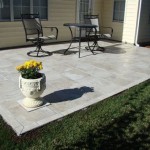Raised Patio Cost: A Comprehensive Guide
A raised patio can transform an outdoor space, adding an elevated level of style and functionality. From creating a distinct seating area to overcoming sloping terrain, raised patios offer numerous benefits. However, before embarking on this project, understanding the associated costs is crucial for informed decision-making. This guide will break down the factors influencing raised patio costs, providing a roadmap for budget planning.
Factors Influencing Raised Patio Cost
The cost of building a raised patio is influenced by several factors, including:
1. Size and Dimensions
The size of the patio directly impacts the amount of materials needed, driving up the cost. A small, intimate patio will naturally require less material than a spacious entertainment area. Consider the desired footprint and its impact on the overall budget. The height of the raised patio will also affect the required material quantity, influencing the final cost.
2. Material Choice
A wide range of materials are available for constructing raised patios, each with its own price point. Some popular options include:
- Concrete: Durable and low-maintenance, concrete is a cost-effective material. However, concrete requires skilled labor for installation, potentially adding to the overall cost.
- Pavers: Offering a range of styles and colors, pavers provide a versatile option for raised patio construction. Their cost varies depending on materials, such as concrete, stone, or brick, and installation complexities.
- Timber: While aesthetically appealing, timber can be more expensive than other materials. The choice of wood type, such as cedar or redwood, further influences the cost. Regular maintenance is needed to prevent decay and ensure longevity.
- Composite Decking: Designed to mimic the look of wood while offering superior weather resistance and durability, composite decking can be an attractive but potentially more expensive option.
The choice of materials is a balancing act between budget, aesthetics, and desired longevity. Research different options thoroughly and consider the long-term costs associated with maintenance and repairs.
3. Foundation and Support Structure
The foundation of a raised patio is essential for stability and longevity. The complexity of the foundation, influenced by factors like soil conditions and patio height, affects the overall cost.
- Footings: For sturdy support, concrete footings are typically required, adding to the overall cost.
- Framing: Timber framing, used for supporting the patio deck, contributes significantly to the cost. The type and size of timber used, along with labor costs, impact the total expense.
4. Labor Costs
The cost of labor is a significant factor in building a raised patio. Skilled labor is required for various tasks, including foundation work, framing, decking installation, and finishing touches. The complexity of the design and the accessibility of the site will influence labor costs.
5. Additional Features
Adding features to a raised patio can enhance its functionality and aesthetics but also increases the overall cost. Some common features include:
- Lighting: Recessed lighting, decorative fixtures, or string lights add ambiance and safety but come at an additional cost.
- Railings: Safety railings, especially for elevated patios, are essential but contribute to the overall cost. The choice of materials, such as wood, metal, or glass, influences the price.
- Fire Features: Fire pits or fireplaces add warmth and atmosphere but require additional planning and construction, increasing expenses.
Cost Estimation and Breakdown
It's challenging to provide a precise cost estimate without specific project details. However, a general breakdown can help in budgeting:
- Materials: 30% to 50% of the total cost
- Labor: 30% to 50% of the total cost
- Foundation: 10% to 20% of the total cost
- Additional Features: 10% to 20% of the total cost
Remember, these figures are estimates and can vary significantly depending on individual project requirements. Consult with contractors and suppliers for accurate cost breakdowns tailored to your specific needs.
Tips for Saving Money
While building a raised patio can be an investment, several strategies can help save money:
- DIY Approach: If you possess construction skills, consider undertaking some tasks independently to reduce labor costs. However, prioritize safety and ensure you have the necessary expertise before attempting complex tasks.
- Simple Design: Opt for a simple and functional design to minimize material requirements and labor costs. Avoid intricate details and focus on practicality.
- Material Comparison: Research different materials, comparing costs, durability, and maintenance needs. Consider options that offer a good balance between price and performance.
- Shop Around: Obtain multiple quotes from different contractors to compare pricing and services. Be transparent about your budget and project expectations.
Building a raised patio is a significant investment that adds value to your property. By understanding the factors influencing costs, considering different material and design options, and implementing cost-saving strategies, you can create a functional and aesthetically pleasing outdoor space within your budget.

How Much Does A New Patio Cost Checkatrade

Two Level Bluestone Patio Costs

How Much Does A New Patio Cost Checkatrade

How Much Does A New Patio Cost Checkatrade

How Much Does A New Patio Cost Checkatrade

How Much Does A New Patio Cost Checkatrade

Deck Vs Patio Steps Down From House To Axel Landscape

How Much Does It Cost To Build A Patio Forbes Home

How Much Does A New Patio Cost Marshalls

Deck Vs Patio Steps Down From House To Axel Landscape
Related Posts








